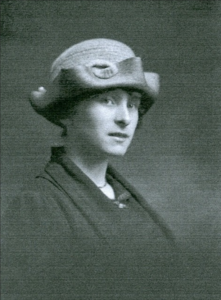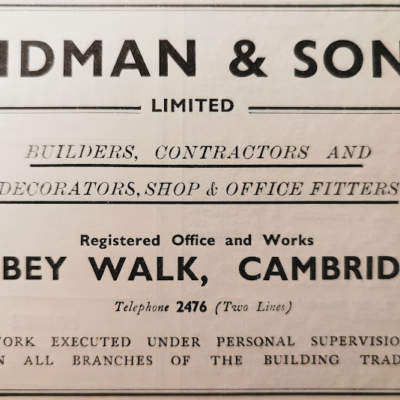Search by topic
- archaeology
- architecture
- bricklayer
- Building of Local Interest
- carpenter
- church
- crime
- dressmaker
- fire
- general labourer
- Great Eastern Railway
- listed building
- medieval
- oral history
- Public House
- Rattee & Kett
- Roman
- scholar
- school
- Then and Now
- tudor
- women
- work
- world war one
- world war two
Search by text
22 Ainsworth Street
Railway Workers and a College Servant
Number 22 is one of a terrace of seven houses on the east side of Ainsworth Street.
1881 – 1891
The Howlett family live at number 22 in 1881 and are still here in 1891.
Head of Household is James, a locomotive engine fireman on the Great Eastern Railway. He is 25 in 1881 and married to Mary from Caxton. At this point they have two daughters, Edith aged 3 and Sarah aged 1.
By 1891 there are four sons. Albert, 9 and Arthur, 7, are at school with they’re older sister Sarah who is now 11. James is 3 and baby Henry is 1.
Educational – Neglecting to send their children regularly to school: – James Howlett, of 22 Ainsworth Street (as to two children). Order was made to send the children to school. Cambridge Independent Press 30 June 1893
They have moved to 6 Ainsworth Street by 1901.
James and Mary are buried in Mill Road Cemetary.
1901 – 1977
Head of Household is Charles Crouch a college servant from Cambridge. On the 1911 Census Charles notes that he is a kitchen porter.
He is married to Clara Louise (nee Peacock) and the 1911 Census records that they have been married for 19 years and their nine children are still alive.
There are five children in 1901. Clara Maud is 8, Ada Evelyn is 7, Charles Ernest is 5, Walter Lesley John is 2 and baby Edward Victor is 2-months-old. The elder children probably go to school, but this information isn’t recorded.
By 1911 there are eight children living at number 22. Ada is helping at home, Charles is an errand boy for a book seller. Walter and Edward are at school. Clara is working as a domestic servant at 2 Park Parade.
The youngest children are Arthur Leonard, 8, Ivy Constance, 7, and Doris Irene, 4. Although they are not recorded on the Census as attending school, Ivy can be found on the Register of Barnwell Girls School in 1912, having previously attended Sturton Street Infants.
There is a new baby, Ena Kathleen, who is 8-months-old.
In April 1914 Charles (the son) joined the Suffolk Yeomanry, and went on to serve with the Royal West Kent Regiment and the Royal Engineers.
A certificate from May 3rd 1917 shows he ‘has been tested in the Workshops of the Railway Operating Division in the Field and proves himself a Proficient Shunter’. A note in his File from 7th August 1917 records that ‘the man named below has just returned from Hospital: Pte C.E Crouch 7th Royal West Kents’. It is addressed to the 45th Broad Gauge Company HQ at Berques.
Railway Operating Division Certificate – certified that Sapper Crouch, CE. Trade – Clerk, Company 45, has executed a piece of work which in my opinion is equivalent to a test as laid down by Corps Memoranda for the Superior rate, and I recommend his Engineer Pay be increased from 1/4d to 1/8d. Date 22.5.1918
The 1921 Census records Charles living in Chesterton with his French wife Marie, who is 22 and was born in Bailleul, and their eleven month old daughter Ernestine, who was born in Vieux-Berques. Charles is a railway goods checker for the Great Eastern Railway, based at the GNR Goods Shed on Hills Road. Online records suggest they married in July 1919, in Vieux-Berquin.
KILLED ON THE LINE – Boy Run Over Near Cambridge Station – A sad fatality occurred on the line at Cambridge yesterday evening. Edward Victor Crouch (17) of 22 Ainsworth Street, employed as a number-taker on the Great Eastern Railway, was on the line near Hills Road Bridge shortly after five o’clock, when he was knocked down by a passenger train from London and killed. Cambridge Independent Press 05 April 1918
Private Walter Leslie John Crouch of the 50th Battalion Machine Gun Corps, was killed in action on the 18th October 1918. [This is Walter’s page on Lives of the First World War. There are photos and remembrances of him in the Multimedia section.]
The 1921 Census for 22 Ainsworth Street records that Clara is now a widow. Cambridgeshire Burial records show that Charles died in January 1912 ‘in hospital’.
Ada is 27 and is a shop assistant at Messrs. Hawkins Ltd, Confectioner of St. Andrew’s Street.
Arthur is 18 and a general labourer. They have noted that his late Employer was Mr Chalice of Trinity Cricket Grounds. Arthur married Maud Hutton in 1938.
Ivy is 17 and an errand girl for Mr Edwards’ Fruiterer of St. Andrew’s Street. Ivy married Frederick Brown in 1929.
Doris is 14 and a domestic servant, day girl, for Dr. Ellis of St. Andrew’s Street. Doris married Percy Marshall in 1932.
Ena is ten and at school full time. She married Frederick Mansfield in 1935, and in 1939 can be found living at 143 Sturton Street.
By the time of the 1939 Register, Clara is living at 22 Ainsworth Street with just daughter Ada who is working as a confectioner in a shop.
Clara died in 1949, and Ada remained at 22 Ainsworth Street until her death in 1977.
Sources: UK census records (1881 to 1921), 1939 Register, Mill Road Cemetery, Cambridgeshire Burials, Geneanet.org, National School Admission Registers & Log-Books (1870-1914), British Army Service Records, Soldiers Died In The Great War 1914-1919, Lives of the First World War,
[RGL adds: the story of Charlie Crouch who signed on to the Suffolk Yeomanry in 1915 and ended up in the Railway Operating Division, part of the Royal Engineers, is told in Barnwell at War (2018)], British Army Service Records
Contribute
Do you have any information about the people or places in this article? If so, then please let us know using the Contact page or by emailing capturingcambridge@
License
 This work is licensed under a Creative Commons Attribution-NonCommercial-ShareAlike 4.0 International License.
This work is licensed under a Creative Commons Attribution-NonCommercial-ShareAlike 4.0 International License.











